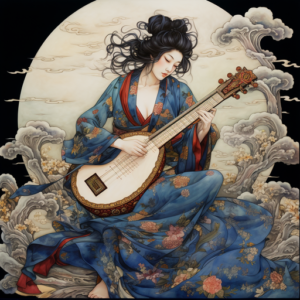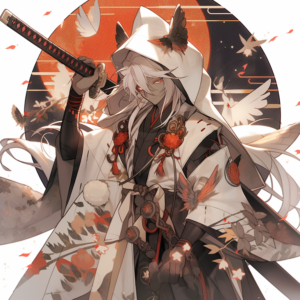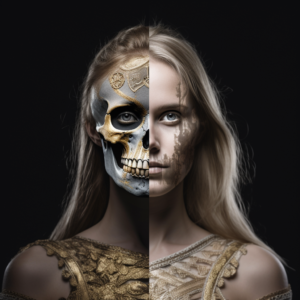Hel is the Norse goddess of the dead. She ruled over the underworld, Niflheim, where she received the dead. Her name means “one that hides.”
In general, Hel is only mentioned in passing in Old Norse literature. It means her character is ill-defined and her personality little-developed. Some historians even suggest that she is a figment of the imagination of the Norse poets.
Family
In Norse mythology, Hel’s father was the trickster god Loki and her mother the giantess Angrboda. Loki and Angrboda had three children: the wolf Fenrir; the serpent Jörmungandr; and Hel, their only daughter.
Hel was born with the bones on one half of her body fully exposed and, thus, is often depicted as a half-black and half-white monster. She grew up with Fenrir and Jörmungandr in Jotunheim, land of the giants, until Odin, ruler of the Aesir, decided they should live in Asgard where their father came from.
Symbols
Hel is associated with a hellhound named Garmr as well as crows. She is also sometimes affiliated with the Hagalaz Rune stone.
Powers & Duties
In Asgard, the other Norse gods were uncomfortable with Hel’s appearance. For this reason, Odin agreed to send her away, and gave her the World of Niflheim – one of the Nine Realms. There she became queen of the dead.
The Norse believed that most people went to Niflheim when they died. Only warriors who were killed on the battlefield did not go to Niflheim. Instead, half of the warriors who died on the battlefield went to live with Odin in his palatial home Valhalla and the other half with Freya in her afterlife realm Folkvangr.
Niflheim was divided into sections, including one called the shore of corpses. Here, a castle filled with venomous serpents stood facing north. It was full of murderers, perjurers, and adulterers who suffered while their blood was sucked by a dragon named Nidhogg.
When Odin’s son Baldur died because of a trick by Loki, his soul was also received in Niflheim. Hermod, another son of Odin’s, agreed to go to Hel to convince her to send Baldur home. But Loki played another trick to make it impossible for Baldur to return to the real world. The eventual exposure of his trickery led to the end of the world, a battle between good and evil known as Ragnarok.
In Niflheim, Hel was waited upon by two servants called Ganglati and Ganglot. It is said they moved so slowly that they appeared to be standing still. They served her meals in a dish named “hunger” and with a knife named “famine.”
Facts About Hel
- Holland, Helvetia, Helsinki, and Holstein are well-known places that were probably named after Hel;
- Hel’s appearance could be the inspiration of the masked harlequin who appeared in Commedia dell’ Arte;
- No-one could hide anything from Hel. She had an eye of fire, which could only see the truth;
- The Vikings feared Hel’s appearance, and they were wary of Niflheim;
- Niflheim was an icy cold place rather than a place of fire and brimstone most associated with the modern idea of hell;
- In the Prose Edda written by Snorri Sturluson in the 13 th century, Niflheim is described as a place where a constant wail can be heard from the residents. It is damp with sleet and the walls are built with worms and the bones of humans;
- In the Gylfaginning, the first part of the Prose Edda, Hel is described as “rather downcast and fierce-looking”;
- Hel was feared by the Vikings, but the Gauls, Dutch, and Germanic peoples were more sympathetic towards her. They did not see Niflheim as a place of punishment and had a kinder approach to death;
- The expression “go to hell” originated with Hel and Niflheim;
- Niflheim existed beneath the roots of the world tree Yggdrasil;
- Jacob Grimm, a scholar of Norse mythology, had a theory that Hel was only a “half-goddess.” He argued that because Loki made the giantess Angrboda pregnant, there was no proof that Hel was of full divine blood;
- Some scholars have suggested that several of the imitation medallions and bracteates which remain from the Migration Period depicts Hel;
- Hela, the fictional villainess in Marvel Comics’ American comic books, is based on Hel. She is also featured in the webcomic The Order of the Stick, in which she is an antagonist who wants to destroy the world.
*As an Amazon Associate I earn from qualifying purchases.






